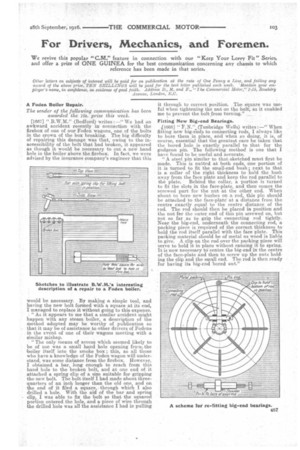For Drivers, Mechanics, and Foremen.
Page 21

If you've noticed an error in this article please click here to report it so we can fix it.
We revive this popular "C,M." feature in connection with our "Keep Your Lorry Fit" Series, and offer a prize of ONE GUINEA for the best communication concerning any chassis to which reference has been made in that series.
Other letters on subjects of interest will be paid for on publication at the rate of One Penny a Line, and failing any award of the above prize, TEN SHILLINGS will be paid for the best letter published each week, 'Mention your ernsame. in .c,onfidence, as evidence of goOd faith. Address D., 31, and E.., "The-Commercial Motor," 7-15, liosebery
• Avenue, Landon, E.O. • A rodeo. Boiler Repair.
Tire ;ender of the following communication has been awarded tire Ws, prize this week.
[1567] ".B.W.M." (Bedford) writes : —" We had an awkward accident recently in: connection with the firebox of one of our Foden wagons, one of the bolts in the crown of the box breaking. The big difficulty of repairing this damage was that, owing to the inaccessibility of the bolt that had broken, it appeared as though it would be necessary to cut a new hand hole in the boiler above the firebox. In fact, we were advised by the insurance company's engineer that this would be necessary. By making a simple tool, and having the new bolt formed with a square at its end, I managed to replace it without going to this expense. . " As it appears to me that a similar accident might happen with any steam boiler, a description of the Method adopted may be worthy of publication so that it may be of assistance to other drivers of Fodens in the event of one of their wagons meeting with a similar mishap.
"The only means of access which seemed likely to be of use was a small hand bolo opening from-, the boiler itself into the smoke box ; this, as all those who have a knowledge of the Foden wagon will understand, was some distance from the firebox. However, I obtained a bar, long enough to reach from this hand hole to the broken bolt, and at one end of it attached a spring clip of a size suitable for gripping the new bolt. The bolt itself I had made about threequarters of an inch longer than the old one, and on the end of it filed a square, through which I also drilled a hole. With the aid of the bar and spring clip, I was able to fix the bolt so that the squared portion entered the hole, and a piece of wire through the drilled hole was all the assistance I had in pulling it through to correct position. The square was useful when tightening the nut on the bolt, as it enabled me to prevent the bolt from turning."
Fitting New Big-end Bearings.
[1688] " (Tunbridge Wells) writes :—" When fitting new big-ends to connecting rods, I always like to bore them in place, and when so doing, it is, of course, essential that the greatest care be taken that the bored hole is exactly parallel to that for the gudgeon pin. The following method is one that I have found to be useful and accurate.
"A steel pin similar to that-sketched must first be made. This is nutted at both ends, One portion of it is turned to fit the small-end bush; next to that is a collar of the right thickness to hold. the bush away from the face plate and keep the rod parallel to the plate. Behind the collar, a portion is turned to fit the slots in the face-plate, and then comes the screwed part for the nut at the other end. When about to bore new bushes on a rod, this pin should be attached to the face-plate' at a distance from the centre exactly equal to the centre distance of the rod. The rod should then be placed in position and the nut for the outer end of this pin screwed on, but not so far as to grip the connecting rod tightly. Near the big-end, underneath the connecting rod, a packing piece is required of the .Correct thickness to hold the rod itself parallel with the face plate. This packing material should be of metal as wood is liable to give. A clip on the rod over the packing piece will serve to hold it in place without causing it to spring. It is now necessary tO centre the big-end in the centre of the face-plate and then to screw up the nuts holding the clip and the small end. The, rod is then ready for having its big-end bored out."






















